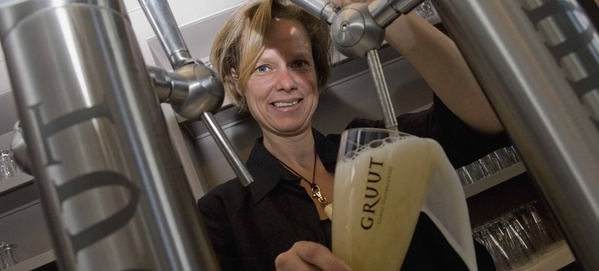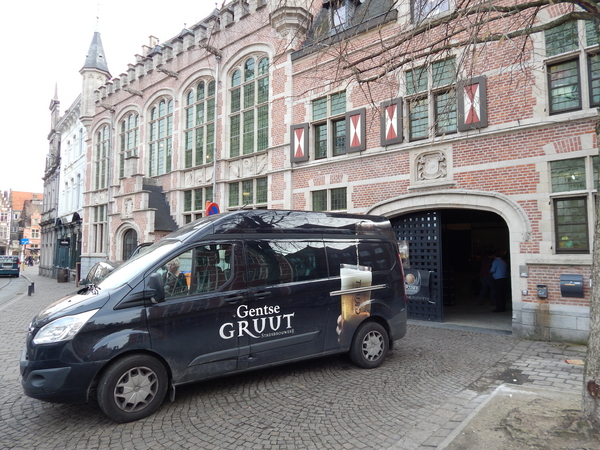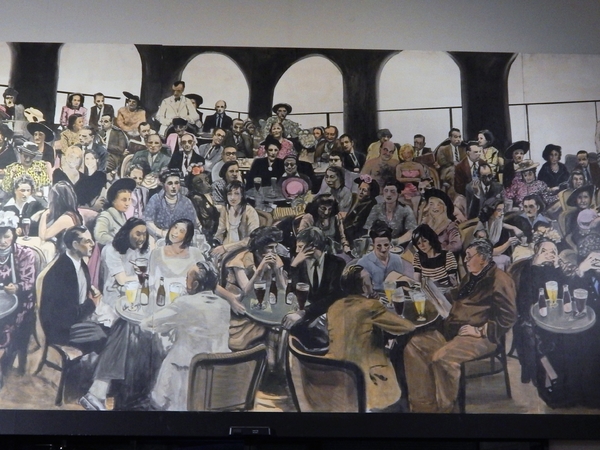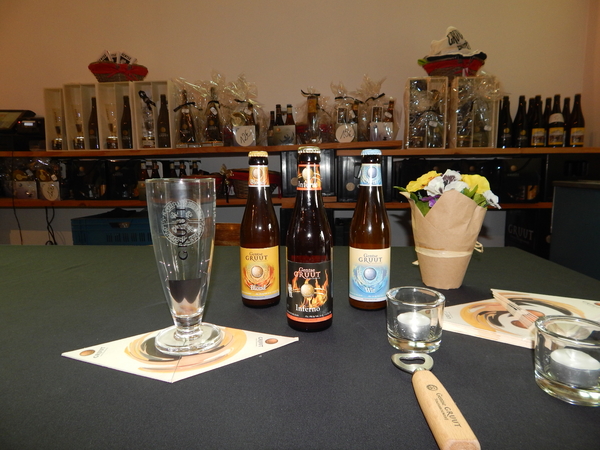Annick's Gruut beer is the spice of life
Added: Sunday, January 31st 2016

If you fancy recreating a medieval beer with fruit, herbs and spices replacing hops, then Gruut in Ghent is the place to head for.
Annick De Splenter not only fashions her own beers with the likes of aniseed, cranberry, fennel and rosemary but she invites members of the public to brew their own beers in her small brewhouse.
In January, Annick moved her brewing equipment from the outskirts of Ghent to a central location in the city’s old fish market. The spacious building stands alongside the river where fish used to be unloaded from boats. Now it’s home to her small copper brewing kit, which can produce 5,000 hectolitres a year, with a bar and ample seating where drinkers can sample her remarkable beers.
And now she has the space to enable keen beer lovers to drop in and, with her guiding hand, make their own brews using grain and a wide variety of flavourings.
Annick can truly be called a brewster, the ancient title for a woman brewer. She comes from proud stock, for the De Splenter family is a brewing dynasty in Belgium. Her father Ivan ran Liefmans in Oudenaarde and Riva in Dentergem while her mother was related to the Van Eecke family that has a brewery in Watou.
Annick is a graduate of Ghent School of Brewing. Her research showed that in the Middle Ages beer was brewed with herbs and spices instead of hops. In areas of the Low Countries controlled by the French, hops were banned and so brewers used a mixture known as gruut or gruit.
But her professor at brewing school said it was impossible to make beer without hops. Undaunted, Annick persevered and got support from the revered brewing scientist Professor Freddy Delvaux at Leuven University, who now runs the De Kroon research brewery. Back in Ghent, her professor relented and put some of his staff on a project to help Annick develop gruut beers.
In 2009 she opened her brewpub and the success of the venture led to the move to the new site in January.

“It’s a different way of making beer,” she says. “It’s soft beer, not aggressive as some hopped beers can be. My beers are not sweet – they’re drinkable. They need herbs for bitterness.”
She vehemently counters the argument that only hopped beer can be free from infection and can age for several years. “Some of my beers are four years old and are still tasting good. And they are very stable.”
Annick’s brewing kit is second hand and she had to adapt the boiling kettle to use “botanicals” rather than hops. She won’t reveal which fruit, herbs and spices she uses in particular beers as she doesn’t want other brewers jumping on her bandwagon and stealing her recipes.
But she is happy to show a list of the ingredients she uses. They include all spice, aniseed, cinnamon, cranberry, fenugreek, ginger, hyssop, juniper, pepper, rosemary, sage and sesame seeds. She admits to using peanuts in one beer, the 8% Brown, an ingredient unlikely to have been available in the Middle Ages.
The five regular beers are White (5%), Blonde (5.5%), Amber (6.6%), Brown and Inferno (9%). White is a wheat beer and is cloudy and extremely pale. It has a big spicy nose and palate with a pronounced hit of ginger, with hints of orange and creamy malt. Fruit and spice combine in the lingering finish.

Blonde in contrast is crystal clear and has a pale gold colour with a peppery and spicy aroma balanced by biscuit malt. The palate is dry with pepper, spices and tart fruit balancing juicy malt. The finish is long, quenching and spicy.
Annick describes her Amber as “old English ale” and she uses some roasted malt along with pale. It lives up to its name with a bright amber colour followed by a nutty, floral aroma with powerful hints of aniseed. It has a bittersweet palate with blood orange fruit, spices and biscuit malt. The finish is long with nutty malt and a late burst of pepper and aniseed.
Crushed peanuts are added at the end of the production of the Brown beer. It has a big oatmeal aroma with peanuts and pepper notes. Sweet malt, spices, blood orange fruit and nuts fill the mouth, followed by a long dry finish with warming alcohol, tart fruit, spices, rich roasted grain and continuing nut notes.
Inferno is Annick’s version of a strong Belgian Tripel. This is the only beer in which she bends to modern brewing practice, with an addition of hops alongside the botanicals. The bright amber beer has a more familiar aroma of floral hops but they are balanced by ripe fruit, toasted grain and herbs and spices. The palate is a heady mix of fruit, grain, spices and hops, followed by a long and complex finish dominated by malt, fruit, herbs and spices.
Customers who brew their own beers at Gruut will be given a choice of essences to flavour their brews, which they can then bottle and design their own labels. Annick’s bottled beers were at first filled for her at the Rodenbach brewery but she’s brought packaging back in house as she is determined to maintain strict control of quality and to avoid infection.
Four cellars are used to store both bottles and kegs. Annick is exporting to Holland, Italy, Spain, Japan, Norway and Britain and is hoping to develop sales in the United States.
Annick and her team are busily turning the ground floor into a comfortable and welcoming bar, complete with the giant mural (above) from the original brewpub that features notable citizens of Ghent and is clearly inspired by the cover of the Beatles’ Sergeant Pepper album. A large adjoining room will be used for concerts and other events and Annick plans to host talks on brewing history in Ghent.
It’s a history that is alive and well at Gruut where brewing’s past and present come together with a range of fascinating and full-tasting beers.
*Brouwerij Gruut, 5 Rekelingestraat, 9000 Ghent. +32 9 269 02 69. www.gruut.be. Open daily from 11am; 2pm Sundays and holidays. Tours available: last visit 6pm.
*Thanks to Visit Flanders.







